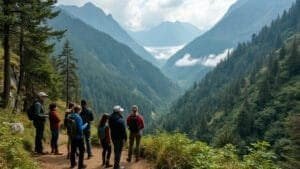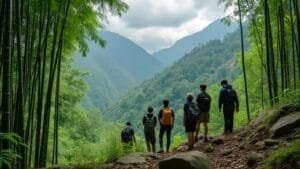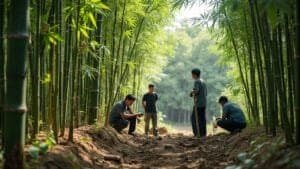Red panda conservation programs are designed to counter the wide range of threats facing one of the most endangered mammals in the Eastern Himalayas. These initiatives aim not only to protect the red panda itself but also to preserve the rich ecosystems it inhabits. From halting deforestation and restoring bamboo forests to empowering local communities and leveraging cutting-edge science, the goals of these programs are multifaceted and far-reaching
In this article, we break down the main goals of red panda conservation programs—focusing on habitat protection, community engagement, anti-poaching enforcement, public education, and international collaboration—each essential to ensuring a sustainable future for this unique species
Key Conservation Goals for Red Panda Survival

Effective conservation of red pandas requires a strategic, multi-layered approach, grounded in the specific ecological and geographical realities of their native habitats. These shy, solitary animals depend on temperate forests rich in bamboo, spanning across Nepal, India, Bhutan, China, and Myanmar
Conservation programs, particularly those led by organizations like the Red Panda Network, WWF India, and national governments, prioritize foundational goals such as protecting red panda habitats and enhancing their connectivity—both of which are critical to sustaining viable populations in the wild
Habitat Protection and Restoration Strategies
The foremost goal of red panda conservation is the protection of existing habitat. Red pandas live in high-altitude forests with dense bamboo undergrowth, and these areas are increasingly under threat from logging, livestock grazing, infrastructure expansion, and agricultural encroachment. The loss of bamboo, which makes up about 95% of the red panda’s diet, directly affects their ability to survive and reproduce
Conservation programs focus on preserving large tracts of intact forest. This includes the establishment and management of protected areas, such as national parks and community forests. For example, WWF India supports habitat conservation in Arunachal Pradesh and Sikkim, while the Red Panda Network has led the development of the PIT Red Panda Protected Forest in eastern Nepal—currently the largest community-protected red panda habitat in the world
Equally important is the restoration of degraded areas. Reforestation with native bamboo species and the replanting of indigenous trees help rebuild red panda habitats that have been damaged or lost. In Nepal, RPN’s “Plant A Red Panda Home” campaign is working toward reforesting critical corridors, with over 800,000 trees planted to date. These efforts not only increase forest cover but also improve climate resilience and enhance water retention in high-altitude ecosystems
Habitat restoration also involves mitigating immediate human impacts. This includes regulating grazing practices, creating firebreaks to prevent forest fires, and working with local governments to limit road construction in sensitive wildlife corridors. Long-term habitat protection hinges on making conservation compatible with sustainable human land use, which ties directly into the next goal: connectivity
Role of Ecological Corridors in Connectivity
Red panda populations are naturally fragmented due to mountainous terrain, but this fragmentation has been exacerbated by human activities. One of the central goals of modern red panda conservation is to restore ecological connectivity through the creation of wildlife corridors. These corridors enable red pandas to move safely between habitat patches for mating, foraging, and genetic exchange—an essential factor in maintaining population viability
Corridors help reduce the risk of inbreeding and ensure that isolated populations do not decline due to limited genetic diversity. These linkages also make it possible for red pandas to adapt to seasonal changes and respond to climate pressures by shifting their range as needed
Corridor development is not just an ecological challenge but also a political and social one. It often involves negotiating land use between multiple stakeholders, from farmers and local councils to national governments and conservation NGOs. In Nepal, community forests have proven to be an effective governance model for maintaining corridor integrity. These are areas managed collectively by local groups who are empowered to enforce conservation rules while benefiting economically from sustainable forest use
The PIT corridor in eastern Nepal is a prime example of how large-scale corridor planning can be successful. Supported by partnerships between RPN, international donors, and community groups, this corridor spans thousands of acres and has become a blueprint for future red panda conservation projects across the Himalayan range
For a deeper look into the scope of these habitat and connectivity strategies, WWF India’s overview of red panda conservation goals offers insights into national-level efforts and how they align with regional biodiversity plans
Community and Technological Approaches to Conservation

While protecting forests is vital, it’s the human dimension of conservation that determines whether red panda protection efforts truly succeed. Community engagement and scientific innovation are both indispensable in ensuring red pandas thrive. From equipping local residents as Forest Guardians to deploying GPS collars and camera traps, modern red panda conservation strategies are increasingly collaborative, inclusive, and data-driven
Local Engagement Through Community-Based Programs
One of the central goals of red panda conservation programs is to make local communities the stewards of conservation. This is particularly important in regions where people live in close proximity to red panda habitats and depend on the same forests for firewood, fodder, and farming. Rather than excluding these communities, successful programs focus on empowering them through sustainable livelihood projects and conservation training
The Forest Guardians initiative developed by the Red Panda Network exemplifies this model. Local individuals are hired, trained, and employed to conduct regular patrols, monitor red panda populations, and report illegal activities such as poaching or deforestation. As of 2024, more than 128 guardians are active across 95 community forests in Nepal. These guardians don’t just serve as eyes and ears in the forest—they become local ambassadors for conservation, spreading awareness in their villages and schools
WWF India follows a similar community-based model, working with indigenous groups and local councils to manage conservation sites in Arunachal Pradesh and Sikkim. Through educational programs, conservation scholarships, and village-level biodiversity committees, they ensure that community voices are central to planning and implementation
In parallel, conservation organizations are addressing poverty-related drivers of habitat loss. Programs promoting clean energy cookstoves reduce dependency on firewood, while eco-tourism and handicraft training provide alternative income. These initiatives help transform conservation from a restriction into an opportunity, reinforcing the idea that local prosperity and environmental stewardship can go hand-in-hand
Use of Monitoring Technology and Field Research
Scientific research plays a critical role in understanding how red pandas interact with their environment and how conservation measures can be fine-tuned. One of the main goals of modern red panda programs is to expand monitoring efforts through technological innovation
Red pandas are elusive, solitary, and largely nocturnal, making them difficult to observe directly. To overcome this, researchers use motion-triggered camera traps that capture red panda movement across landscapes. These devices are strategically placed along trails, nesting areas, and feeding zones to gather data on activity patterns, behavior, and population density
In addition, GPS collaring studies have significantly advanced red panda conservation. The first such study, conducted by the Red Panda Network in partnership with Rotterdam Zoo, provided groundbreaking insights into red panda home ranges, travel routes, and habitat preferences. This information is vital for identifying which forest patches should be protected or reconnected via ecological corridors
Beyond tracking, genetic sampling is becoming increasingly common. Researchers analyze fecal samples and hair to study genetic diversity, identify distinct subpopulations, and monitor health indicators. These data inform breeding programs and help conservationists determine where to focus restoration or protection efforts
Technological tools are also improving data sharing across borders. Conservation platforms allow scientists, NGOs, and governments in India, Nepal, Bhutan, and China to coordinate their efforts. Standardized data protocols and regional databases facilitate collaboration, helping all stakeholders track the effectiveness of conservation actions
For a closer look at how local communities and scientists collaborate on red panda conservation, the Red Panda Network’s conservation program page offers detailed insights into how technology and grassroots involvement are reshaping red panda protection
Addressing Trade Threats and Expanding Global Support

Conserving red pandas requires more than habitat protection and field research—it also demands direct intervention against poaching and illegal trade, as well as cultivating global awareness and support. As red pandas face threats from wildlife trafficking and lack of international visibility, conservation programs prioritize enforcement, education, and collaborative efforts that scale across borders
Anti-Poaching and Trade Enforcement Measures
Red pandas are increasingly targeted for their pelts and as exotic pets, making anti-poaching efforts a core component of conservation. While poaching may not be as visible as habitat destruction, its impacts are devastating, particularly for a species with low reproductive rates and naturally small population sizes
Conservation programs work to reduce poaching through several mechanisms. First, they engage communities in surveillance and response through programs like Forest Guardians, who are trained to detect and remove snares, report poaching incidents, and deter illegal forest activities. These patrollers operate regularly in key habitats, making it harder for poachers to act undetected
Second, legal frameworks are being strengthened and more consistently enforced. Organizations like WWF India work with forest departments to train rangers, improve enforcement logistics, and help implement national wildlife laws that protect red pandas under Schedule I of India’s Wildlife Protection Act and Appendix I of CITES (the Convention on International Trade in Endangered Species of Wild Fauna and Flora)
Awareness campaigns also help reduce the demand side of wildlife crime. In places like Bhutan and Nepal, where red panda pelts have cultural value, educational outreach is used to shift perceptions and emphasize the animal’s endangered status. These programs often involve respected community leaders, teachers, and religious figures, adding moral weight to legal protections
Education and Outreach Initiatives for Awareness
Public education is a vital goal for any species-focused conservation program, and red pandas are no exception. Conservationists work to increase awareness of red panda threats and promote behavior changes that support forest and wildlife health
At the community level, education takes the form of workshops, classroom programs, and storytelling campaigns tailored to rural populations. In red panda range areas, local NGOs distribute materials in native languages, conduct forest walk events, and run school-based conservation clubs. The Red Panda Network has integrated its curriculum into more than 100 schools in Nepal and continues to expand its youth outreach
Globally, events like International Red Panda Day (celebrated annually on the third Saturday of September) engage thousands of supporters through zoo-based programs, social media challenges, and public fundraising campaigns. These events serve to boost visibility, foster emotional connection with the species, and generate vital funds for fieldwork
In the digital space, conservation groups now use engaging content—from live red panda cams to virtual adoption kits—to bring red panda conservation into homes and classrooms worldwide. These tools are essential for raising long-term support and building an international network of advocates
International Collaboration and Long-Term Conservation Impact
Red panda conservation cannot be achieved by a single country or organization. Red pandas inhabit transboundary landscapes that stretch across Nepal, India, Bhutan, Myanmar, and China. International collaboration is therefore a foundational goal of effective conservation programming
Organizations like WWF, the Red Panda Network, and governmental agencies work across borders to share knowledge, harmonize conservation policies, and fund joint research. This includes developing shared monitoring protocols, cross-border ecological corridors, and coordinated anti-poaching campaigns
One example is the Bhutan Red Panda Conservation Action Plan, developed with support from RPN and Bhutan’s Nature Conservation Division. This strategic document outlines how the country’s conservation efforts will align with international red panda priorities while respecting national sovereignty and local community roles
Another critical outcome of international collaboration is the ability to scale what works. Successful models—like Nepal’s PIT corridor or India’s use of community-managed forests—can be adapted and applied across regions facing similar challenges
The long-term goal of all these efforts is clear: stabilize and grow wild red panda populations by securing their habitats, supporting the communities who live alongside them, and building a global coalition that recognizes red pandas as an irreplaceable part of Earth’s biodiversity. For a clear summary of how local and international partnerships contribute to these goals, check the Cincinnati Zoo’s feature on red panda conservation programs











